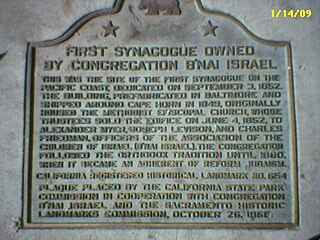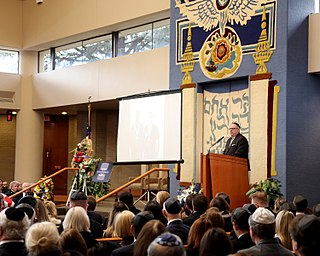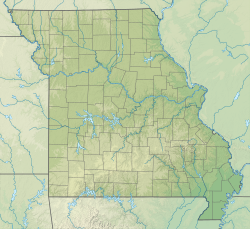The history of Jews in St Louis goes back to at least 1807. St. Louis has the largest Jewish population in Missouri and is the largest urban area in the state of Missouri. Today's Jewish community is primarily composed of the descendants of Jews who immigrated from Germany in the first few decades of the 19th century, as well as Jews who came from Eastern Europe slightly later.

Mount Zion Temple is a Reform Jewish synagogue located at 1300 Summit Avenue, in St. Paul, Minnesota, in the United States. Founded in 1856 as Mount Zion Hebrew Association, it was the first Jewish congregation in Minnesota. The congregation was formed before the statehood of Minnesota in 1858.

Adas Israel Congregation was a Modern Orthodox Jewish synagogue located in Duluth, Minnesota, established in the late 19th century. Until its destruction by arson on September 9, 2019, it was the oldest surviving Orthodox synagogue in Duluth having outlived and incorporated several Orthodox synagogues in the Twin Ports area. By 1973, it was the only Orthodox synagogue in Duluth.
B'nai Emet Synagogue is a former Conservative Jewish congregation and synagogue located on Ottawa Avenue, in St. Louis Park, Minnesota, in the United States.
Congregation Am Tikvah is a combined Conservative and Reform Jewish congregation and synagogue located at 625 Brotherhood Way in San Francisco, California, in the United States. The congregation was formed in 2021 as the result of the merger of the Conservative B'nai Emunah and the Reform Beth Israel Judea congregations, with the latter formed in 1969 through a merger of the Conservative Congregation Beth Israel and the Reform Temple Judea. The congregation is affiliated with both the Union for Reform Judaism and the United Synagogue of Conservative Judaism.

Adas Israel is a Conservative synagogue in the Cleveland Park neighborhood of Washington, D.C., in the United States. It is the largest Conservative synagogue in the city.

Congregation B'nai Israel is a Reform Jewish congregation and synagogue, located at 3600 Riverside Boulevard, in Sacramento, California, in the United States. Founded in 1852 as an Orthodox community, the congregation is the oldest Jewish congregation in Sacramento. The congregation dates the California Gold Rush of 1849, when Jewish settlers gathered to observe the High Holy days. The congregation purchased its first building at 7th and L streets on September 2, 1852, making it the first synagogue west of the Mississippi River.

B'nai Jeshurun is a non-denominational Jewish synagogue located at 257 West 88th Street and 270 West 89th Street, on the Upper West Side of Manhattan, in New York City, New York, United States.

Ansche Chesed is a Conservative synagogue located at West End Avenue and 100th Street on the Upper West Side of Manhattan in New York City, New York, United States.
Congregation B'nai Israel is a Reform Jewish congregation and synagogue located at 2710 Park Avenue, in Bridgeport, Connecticut, in the United States.
Congregation B'nai Amoona is an egalitarian Conservative synagogue, located at 324 South Mason Road, Creve Coeur, Missouri, in the United States. It evolved from a small Orthodox congregation of primarily German-speaking members into an English-speaking Conservative congregation.
Daniel Block was a Jewish leader who founded the B'nai B'rith synagogue in St. Louis, Missouri. He lived for only four years in the United States but he made important contributions on the culture of the St. Louis Jewish community to which he belonged. Between his arrival in about 1848, and his death in 1853, he contributed greatly to the organization and development of B'nai El congregation.

Temple Israel is a Reform Jewish congregation and synagogue located at 1376 East Massey Road, in Memphis, Tennessee, in the United States. It is the only Reform synagogue in Memphis, the oldest and largest Jewish congregation in Tennessee, and one of the largest Reform congregations in the U.S. It was founded in 1853 by mostly German Jews as Congregation B'nai Israel. Led initially by cantors, in 1858 it hired its first rabbi, Jacob Peres, and leased its first building, which it renovated and eventually purchased.

Temple Emanuel is a Reform Jewish synagogue located at 12166 Conway Road, near the corner of New Ballas Road, in Creve Coeur, Missouri, in the United States. Organized in 1956, it is affiliated with the Union for Reform Judaism (UAHC). It has a membership of 300 families.
Shaarey Tphiloh is a Modern Orthodox Jewish congregation and synagogue located at 400 Deering Avenue, in Portland, Maine, in the United States. The congregation claims it is the oldest continuously operating synagogue in Portland. The name of the synagogue literally means "Gates of Prayer" in Hebrew.
Belsize Square Synagogue is a continental Liberal Jewish congregation and synagogue, located in Belsize Park, Hampstead, in the Borough of Camden, London, England, in the United Kingdom. The congregation is independent of the two Progressive (Reform) Jewish movements in the United Kingdom, drawing from the worship tradition of German Liberal Judaism.

Congregation Shaare Emeth is a Reform Jewish congregation and synagogue located at 11645 Ladue Road, in Creve Coeur, St. Louis County, Missouri, in the United States.

B'nai Israel Congregation is a Conservative Jewish egalitarian congregation and synagogue, located in Rockville, Maryland, in the United States. B'nai Israel's mission is to study in the Jewish tradition, worship God, commit to social action, and address the needs of the Jewish people locally, in Israel, and worldwide. The congregation consists of 1,200 families.

Temple B'nai Israel is a Reform Jewish congregation and synagogue located at 4901 North Pennsylvania, Oklahoma City, Oklahoma, in the United States. The congregation is the oldest active Jewish congregation in Oklahoma.












